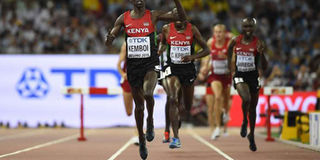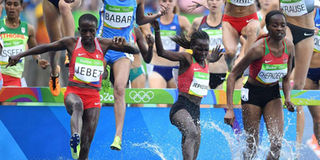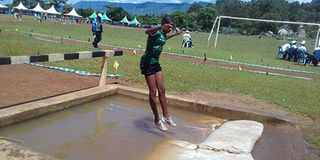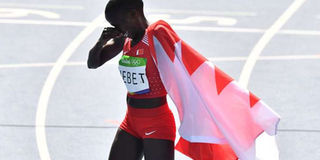The history of the 3000m steeplechase race

Kenya's Ezekiel Kemboi celebrates winning the final of the men's 3,000 metres steeplechase athletics event at the 2015 IAAF World Championships at the "Bird's Nest" National Stadium in Beijing on August 24, 2015. PHOTO | OLIVIER MORIN | AFP
What you need to know:
- The obstacles for the men are 914 millimetres high, and for the women 762 millimetres. The diagonal frame measures 3.94 metres.
Steeplechase race is one of the most technical track events in the Olympic Games, Commonwealth Games and the World Championships in athletics.
This is an event where athletes compete in scaling over four ordinary barriers and one water jump in a circuit. The senior athletes and Under-20 athletes’ races cover 3,000m while Under-18 and veteran races are 2,000m.

From left: Barhain's Ruth Jebet, Kenya's Hyvin Kiyeng Jepkemoi and Kenya's Beatrice Chepkoech compete in the Women's 3000m Steeplechase Final at the Rio 2016 Olympic Games at the Olympic Stadium in Rio de Janeiro on August 15, 2016. PHOTO | JOHANNES EISELE |
The obstacles for the men are 914 millimetres high, and for the women 762 millimetres. The diagonal frame measures 3.94 metres.
The water jump consists of a barrier followed by a pit of water with a landing area 3.66 metres wide × 0.70 metres (2.3ft). It then slopes upward from 700 millimetres (28 in) deep to level with the surface of the track.
TRACK
Over 3,000m, each runner must clear a total of 28 ordinary barriers and seven water jumps. This entails seven complete laps after starting with a fraction of a lap run without barriers.
The water jump is located on the back turn, either inside the inner lane or outside the outer lane. If it is on the outside, then each of the seven laps is longer than the standard 400 m, and the starting point is on the home straight. If the water jump is on the inside, each lap is shorter than 400m, the starting point is on the back straight, so the water jump and barrier in the home straight are bypassed in the first half lap at the start.
Unlike those used in hurdling, steeplechase barriers do not fall over if hit, and rules allow an athlete to negotiate the barrier by any means, so many runners step on top of them.
WATER JUMP
Four barriers are spaced around the track on level ground, and a fifth barrier at the top of the second turn (fourth barrier in a complete lap from the finish line) is the water jump.
The slope of the water jump rewards runners with more jumping ability, because a longer jump results in a shallower landing in the water.

Lucy Chepkirui from Mosoriot Teachers College clears a water jump hurdle on her way to victory in the 3,000m steeplechase during the Kenya Training Teachers College National Athletics Championships held in Tambach, Elgeyo Marakwet County on May 16, 2018. PHOTO | BERNARD ROTICH |

Kenya's Cellphile Chepsol goes over the water jump on course to victory in the women's 3,000m steeplechase race in the IAAF Diamond League at Eugene's Hayward Field, USA on May 26, 2017. PHOTO | IAAF |
Kenya has dominated to make the men’s races their tradition at the Olympics, World Championships and Commonwealth Games.
Kenya has dominated in men’s race at the Olympics since their maiden victory at the 1968 Summer Games in Mexico City where Amos Biwott made history as the first Kenyan winner. Legendary Kipchoge Keino became the second Kenyan to grab gold at the 1972 Munich Olympics.
Kenya missed out at 1976 Montreal and 1980 Moscow Summer Games but they have managed to stump their authority since then, winning the next nine editions including podium sweeps at 1992 Barcelona and 2004 Athens.
Ezekiel Kemboi is the only other man to have won two Olympics in 2004 Athens and 2012 London besides Volmari Iso-Hollo of Finland at 1932 Los Angeles and 1936 Berlin. In fact, Iso-Hollo remains the only man to have won back-to-back Olympic titles.

Kenya's Ezekiel Kemboi (centre) leads the pack in the heats of the men’s 3,000 metres steeplechase athletics event at the 2015 IAAF World Championships at the "Bird's Nest" National Stadium in Beijing on August 22, 2015. PHOTO | PEDRO UGARTE | AFP

Kenya's Ezekiel Kemboi celebrates winning the final of the men's 3,000 metres steeplechase at the 2015 IAAF World Championships at the "Bird's Nest" National Stadium in Beijing on August 24, 2015. PHOTO | OLIVIER MORIN |

Kenya's Ezekiel Kemboi celebrates winning the final of the men's 3,000 metres steeplechase athletics event at the 2015 IAAF World Championships at the "Bird's Nest" National Stadium in Beijing on August 24, 2015. AFP PHOTO | OLIVIER MORIN
Women’s 3,000m steeplechase was introduced at the 2008 Beijing Olympic Games and even though Kenya is yet to win the title, they have medals in the three editions so far. It’s Kenyan-born Ruth Jebet of Bahrain who won the 2016 Rio Games.

Bahrain's Ruth Jebet celebrates after she won the Rio Olympic Games women's 3000m steeplechase final at the Olympic Stadium in Rio de Janeiro on August 15, 2016. PHOTO | JEWEL SAMAD | AFP
Kenya men have win 12 World titles, only missing out in four at the two opening editions of 1983 Helsinki and 1987 Rome. The only other time was at 2003 Saint-Denis and 2005 Helsinki where Kenyan-born Saif Saaeed Shaheen of Qatar won. He still holds the men's world record in the event.
Kemboi is the most successful athlete in the World Champions, wining four straight gold medals from 2009-2015, beating legendry Moses Kiptanui’s hat-trick in 1991, 1993 and 1995. Kiptanui never won an Olympic title.
From the seven editions of the women’s race that was introduced in 2005 Helsinki, Kenya has the most wins with two titles; Milcah Chemos at 2013 Moscow and Hyvin Kiyeng at 2015 Beijing.

Kenya's Hyvin Kiyeng celebrates after winning the final of the women's 3000 metres steeplechase athletics event at the 2015 IAAF World Championships at the "Bird's Nest" National Stadium in Beijing on August 26, 2015. PHOTO | OLIVIER MORIN | AFP
Apart from the inaugural World Under-20 Championships in 1986 that featured 2,000m steeplechase, Kenyan men have gone to win all the 15 editions of the 3,000 steeplechase.
The women’s 3,000m steeplechase was introduced in 2004 where Kenya has won six of the seven editions, missing out only in 2014 when Kenyan-born Bahraini Ruth Jebet won.





